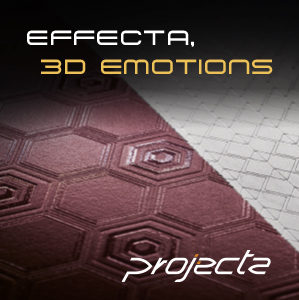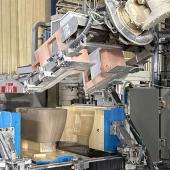Design trends: A stellar year
Pamela Albanese - Tosilab
How long will a trend last? This is the question that always arises when we see a new direction timidly beginning to emerge. In general, a trend is first perceived as a weak signal, a mere trace that gradually takes on more substantial form until a clear road forward becomes visible. But will this road be a straight line or one hairpin bend after another? How many other roads will it intersect along the way? Where will it lead and for how long will we travel it?
Experience has taught us that questions like these are difficult to answer while the trend is still in the pre-emergence phase. It is only as it evolves that we will get a clearer idea of its future development.
Nonetheless, some trends by their nature have almost run their course as soon as they come into being, with boundaries that leave little room for expansion. They are not sufficiently long-lasting or conceptual to evolve into – or even influence – other trends. Unlike major trends which can easily evolve and cross over into other areas, these short-lived fashions or fads are limited in scope and soon die out.
The intergalactic trend belongs to this category. But regardless of its duration it cannot be ignored because it has an important recurring place in the firmament of design and beyond.
After all, even fads re-emerge cyclically over the years. If we could compile a history of trends going back far enough in time, this would surely count as one of those that have occurred most frequently throughout the history of mankind.
The design world’s fascination with the night sky first focused on a relatively nearby icon of the extra-terrestrial universe, the moon. This led to the emergence of surfaces featuring craters reminiscent of those of the lunar crust, faithfully rendered in grey scale, and fuelled the popularity of natural materials such as travertines and logs which spontaneously display these characteristic surface cavities. The moon itself set in a soft, suffused environment provides decorative inspiration for prints, while its forms lend themselves to the design of lamps and objects that simulate the lunar phases. One such example is the Occa Lamp, an interactive prototype created by Mikael Martinsson.
Alongside this moon style we find a wealth of imagery inspired by spacecraft and space stations, from lunar landing icons to modern revisitations of equipment such as spacesuits, space helmets and metal oxygen tubes. Over the past year and a half cinemas seem to have been screening one space-inspired film after another, such as The Arrival, Passengers, Guardians of the galaxy II, Rogue One: A Star Wars Story and so on.
The thousand shades of grey of lunar atmospheres and the dark horror vacui of black holes are counterbalanced by multicoloured hyperbolae reminiscent of distant galaxies. This revisitation of planetary atmospheres is strongly influenced by eighties sci-fi imagery, filtering our renewed passion for the cosmos through the vintage and opulent gaze of that period.
Likewise, on this year’s catwalks there is no shortage of stellar-inspired garments, star-like forms and galactic dresses featuring a play of cosmic and ironic elements. Falling stars come to earth on couture dresses, shoes and handbags, such as Yves Saint Laurent’s Super Star sneakers, Christian Dior’s L’Etoile t-shirts and the Zodiac jacket with Lesage embroidery from Schiaparelli.
And even if we are unable to discern a specific star motif on clothes, we cannot fail to notice the twinkling fabrics created by powders and metallic inserts. The same applies to the world of makeup which references the hostesses in Stanley Kubrick’s 2001: A Space Odyssey. For its forthcoming collection, Chanel has designed a store window where silver pipes typical of spacecraft surround a woman ready for takeoff, accompanied by futuristic makeup inspired by vintage imagery. Similarly, La Perla has created a store window inspired by the classical heroine Hypatia and the age-old study of astrology, a triumph of blue and gold with mannequins gazing skyward. The desolate red Martian landscape, punctuated only by silvery reflecting spheres, serves as the backdrop to Colmar’s latest advertising campaign.
This galactic trend of the catwalks is bubbling over into the world of home décor, bringing us furnishings and surface coverings inspired by boundless skies and polychromatic constellations. Diesel Living, together with Seletti, continues to promote its visionary Cosmic Dinner collection consisting of plates representing the nine planets of the solar system, ideal both for dining and as wall decorations, as well as astronaut-shaped vases and missile-shaped salt and pepper pots.
Even the minimalist Scandinavian design has succumbed to the alien influence, as evidenced by the ultra-sober Lammhults brand which has interpreted its modular chairs with deep blue fabrics sprinkled with glittering stardust. And the avant-garde pavilion of the Stockholm Furniture & Light Fair, which showcases the work of design schools and independent designers, this year featured a section populated by materials seemingly from other planets, including nuggets of silvery asteroids, potential sidereal fossils and Martian moulds that push back the boundaries of science fiction.
In the arts, one of the most emblematic cases of an interstellar vision is the work of German photographer Michael Najjar, who in his biography describes himself as an “adventurer and future astronaut”. All of his work centres around the exploration of space and the possibility of living there in the future. His website adheres strictly to the theme and he has repeatedly stated his intention of becoming the first artist to fly on the Virgin Galactic spacecraft.
So it hardly came as a surprise when Kameha Gran Zurich Hotel recently commissioned him to customise its prestigious Space Suite. With its roof and floors littered with interstellar debris, a floating bed and space travel-inspired furnishings, this suite catapults its guests into a decidedly planetary dimension.
Returning to design, meteorite showers are evoked by surfaces created from recomposed inert mineral flakes. In the language of interior design, these surfaces consist of artificial agglomerates of quartz, marble, glass and granite and simulate traditional terrazzo pavings with a strongly contemporary flavour. It’s a short step from man-made rocks to those that are found in nature, natural compositions and the fragmented breccia marble look that is extremely popular for covering floors and walls.
This passion for almost alien-looking fragments breaks out of the world of surface coverings and extends as far as furnishing accessories and even fabrics and upholstery. So whether it is a rising star or an ephemeral meteorite shower, this stellar trend has pulled us all into its orbit, eager as we are to discover how human life will evolve beyond the Earth’s atmosphere.
Did you find this article useful?
Join the CWW community to receive the most important news from the global ceramic industry every two weeks





















